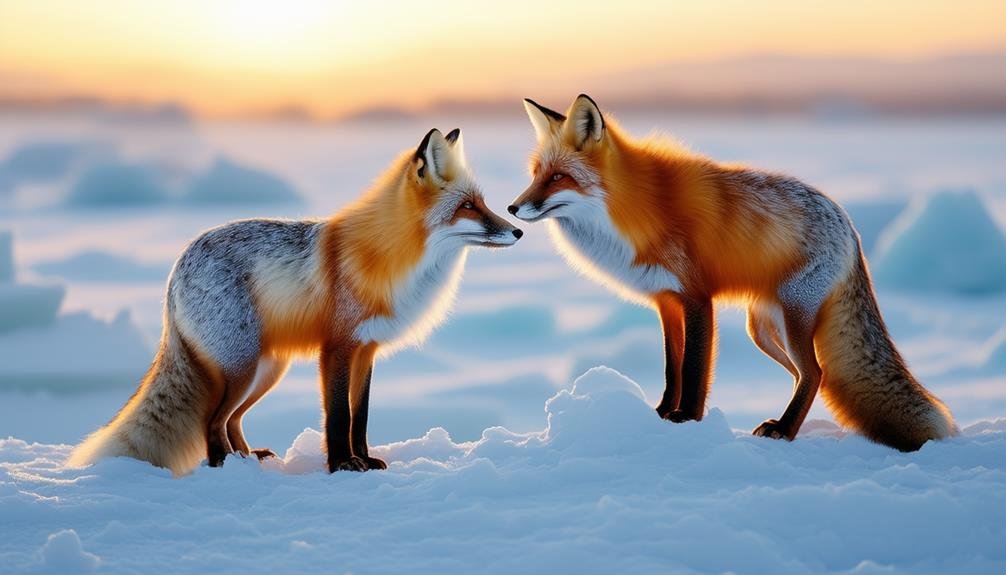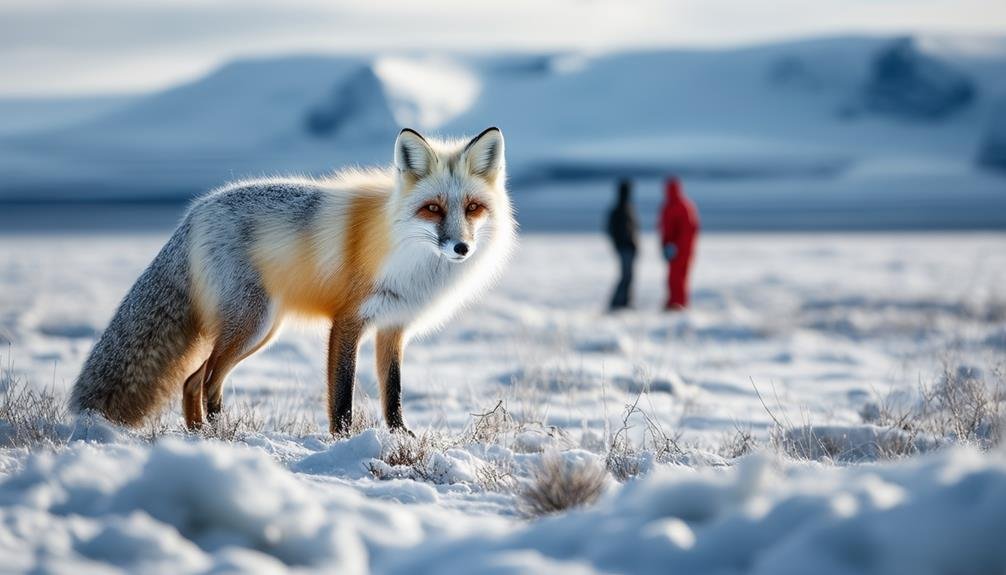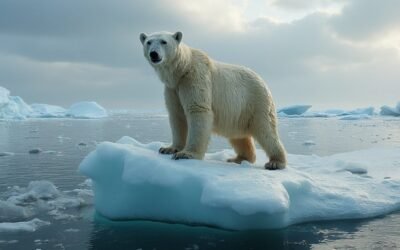Arctic foxes play an essential role in maintaining the Arctic ecosystem's balance. As opportunistic omnivores, they regulate small mammal populations, which helps control vegetation health. Their denning activities enhance soil fertility by depositing necessary nutrients, fostering plant productivity and biodiversity. However, climate change poses significant threats, causing habitat loss and reducing prey availability. Competition with red foxes intensifies, leading to higher predation and food scarcity. Conservation strategies, including habitat protection and climate adaptation measures, are crucial for their survival. Understanding the multifaceted role of Arctic foxes sheds light on preserving the fragile Arctic ecosystem. Discover more about their impact and conservation.
Main Points
- Arctic foxes regulate small mammal populations, maintaining ecological balance in the Arctic tundra.
- Their denning activities enhance soil fertility, promoting plant growth and biodiversity.
- Seasonal fur color change helps Arctic foxes avoid predators, maintaining their survival and ecosystem role.
- Arctic foxes contribute to nutrient cycling, increasing soil nutrient levels and vegetation biomass around dens.
- They indirectly influence plant diversity and vegetation patterns through their impact on herbivore populations.
Arctic Fox Overview
Inhabiting the Arctic tundra and coastal regions of the Northern Hemisphere, Arctic Foxes play an essential role in their ecosystem. These remarkable creatures are pivotal in regulating small mammal populations, particularly those of lemmings and voles, within the Arctic ecosystems. This predatory behavior helps maintain ecological balance, preventing overpopulation and subsequent habitat degradation.
Arctic Foxes are well-adapted to their harsh environments, boasting a dual-layered fur coat that provides insulation against extreme cold. This fur changes color seasonally—from white in winter to brown or grey in summer—to offer effective camouflage in varying landscapes. As opportunistic omnivores, Arctic Foxes display dietary flexibility, feeding on small mammals, birds, fish, and even plant matter, depending on availability and seasonal conditions.
Conservation efforts are critical to the survival of Arctic Foxes, focusing on protecting their critical habitats and monitoring population trends to secure their numbers remain stable. These efforts are essential as changes in their environment and competition with other predators can impact their survival. By safeguarding the Arctic tundra and coastal regions, we can help sustain the delicate balance of these unique ecosystems and guarantee the continued presence of the Arctic Fox.
Climate Change Effects
Climate change impacts Arctic Foxes through habitat loss, reduced prey availability, and increased predation pressure. Milder winters and deteriorating snow conditions lead to fewer suitable dens, while diminished sea ice limits access to marine prey. These changes threaten Arctic Fox survival, necessitating focused conservation efforts to preserve their habitat and enhance food sources.
Habitat Loss Impact
The ongoing loss of habitat due to climate change poses a major threat to Arctic Fox populations by reducing the availability of suitable denning sites. Arctic fox habitats are being severely impacted by the effects of climate change, leading to significant habitat loss. As sea ice diminishes, the duration of access to marine prey shortens, directly affecting prey availability and consequently, the food resources essential for Arctic Fox survival.
Arctic Fox populations face challenges from the deteriorating snow conditions which further compromise the stability and suitability of den sites. The impacts of climate change are profound, causing a decline in sea ice, which not only limits movement but also disrupts breeding sites. Conservation measures, hence, emphasize habitat preservation to mitigate these adverse effects. Efforts are directed towards enhancing prey availability to support Arctic Fox populations amidst these climate change effects.
| Impact | Consequence |
|---|---|
| Habitat loss | Fewer suitable denning sites |
| Decreased sea ice | Limited access to marine prey |
| Deteriorating snow | Unstable den conditions |
| Decline in sea ice | Disrupted movement and breeding |
| Conservation measures | Focus on habitat preservation |
The future of Arctic Foxes hinges on effective conservation strategies to secure their survival amidst changing climatic conditions.
Prey Availability Decline
Amidst the changing Arctic landscape, the decline in prey availability due to climate change presents a significant challenge to the survival of Arctic Fox populations. This issue is primarily driven by the impact of warming temperatures on rodent populations, particularly lemmings, which form the cornerstone of the Arctic Fox diet. As the snow conditions fluctuate, so does the abundance of these rodents, leading to significant food scarcity for the foxes.
Additionally, the reduction in sea ice duration further exacerbates the problem. Sea ice is essential for Arctic Foxes to access marine prey, which supplements their diet when terrestrial food sources are scarce. The diminished sea ice restricts this important access, compelling the foxes to adapt their hunting strategies and dietary preferences to survive.
- Rodent populations: Fluctuating numbers due to changing snow conditions impact food sources.
- Sea ice duration: Reduced sea ice limits access to marine prey, increasing food scarcity.
- Hunting strategies and dietary preferences: Forced adaptation due to changing prey availability.
Addressing climate change and its effects on prey availability is vital to maintaining ecosystem balance and ensuring the survival of Arctic Fox populations. Without intervention, the decline in prey availability poses a severe threat to their continued existence.
Increased Predation Pressure
Increased predation pressure from expanding red fox populations is a direct consequence of warming winters, which facilitate their incursion into Arctic fox territories. The red fox population's northward expansion intensifies competition for resources, severely impacting the Arctic fox. As both species vie for limited food sources, particularly during periods of food scarcity, the Arctic fox faces increased threats to its survival.
Climate change further exacerbates this situation by contributing to a decline in lemming populations, a primary food source for the Arctic fox. This decline forces Arctic foxes to compete more aggressively for the remaining prey, which is also targeted by the more dominant red fox. Consequently, the predation pressure on Arctic fox populations grows, compounding the challenges they face.
Moreover, red foxes introduce diseases and parasites to Arctic fox populations, posing additional threats to their health and further complicating Arctic fox conservation efforts. The climate change impact on these dynamics underscores the urgent need for thorough strategies to protect Arctic foxes from the encroaching red fox population. Addressing these factors is vital for mitigating the predation pressure on Arctic foxes and ensuring the stability of the Arctic ecosystem.
Competition With Red Foxes

Competition with red foxes poses a crucial threat to the Arctic fox populations, as red foxes out-compete them for both prey and den sites. This intensified competition has been exacerbated by changing environments, which have facilitated the northward expansion of red fox populations. Consequently, Arctic foxes are increasingly facing challenges that endanger their survival.
Key factors contributing to this competition include:
- Prey populations: Declines in prey have heightened the struggle for food, with red foxes often dominating over Arctic foxes.
- Den sites: Red foxes tend to occupy and defend the best den sites, leaving Arctic foxes with suboptimal or no denning options.
- Disease transmission: Close proximity to red foxes increases the risk of disease transmission, further endangering Arctic fox populations.
The increased presence of red foxes also leads to higher predation rates on Arctic foxes, adding another layer of vulnerability. This competition and predation contribute significantly to the endangered status of Arctic fox populations. Furthermore, the resilience of red foxes in various climates enables them to adapt more readily to environmental changes, leaving Arctic foxes at a disadvantage. As a result, it is essential to closely monitor and manage this interspecific competition to protect the vulnerable Arctic fox.
Nutrient Cycling Role
Arctic foxes greatly contribute to nutrient cycling in the Arctic ecosystem through their denning activities, which deposit organic matter and nutrients into the soil. This activity enhances soil fertility, leading to increased vegetation biomass around den sites compared to control locations. Consequently, the nutrient distribution influenced by Arctic foxes creates spatial heterogeneity, impacting plant growth and tundra conditions.
Enhanced Soil Fertility
The dens of Arctic foxes greatly enrich soil fertility by depositing essential nutrients such as nitrogen and phosphorous. These nutrient inputs play a pivotal role in nutrient cycling, notably enhancing plant productivity and species diversity in tundra ecosystems. Soil nutrient dynamics in Arctic fox dens reveal higher concentrations of nitrogen and phosphorous compared to surrounding control sites, underscoring the foxes' role as chemical ecosystem engineers.
- Enhanced Plant Productivity: The increased nutrient availability in Arctic fox dens promotes the growth of various plant species, leading to a more efficient tundra ecosystem.
- Species Diversity: The nutrient-rich soil supports a wider variety of plant species, contributing to higher biodiversity in these areas.
- Spatial Heterogeneity: Arctic foxes create patches of nutrient-rich soil, leading to diverse vegetation patterns and influencing overall tundra conditions.
Vegetation Biomass Boost
Fox dens act as nutrient hotspots, significantly boosting vegetation biomass in tundra ecosystems through enhanced nutrient cycling. Arctic fox dens notably contribute to the richness of tundra vegetation by facilitating nutrient additions. Nutrients such as inorganic nitrogen and phosphorous are more concentrated in soils around these dens, supporting the growth of lush green vegetation compared to control sites. This nutrient enrichment arises from fox denning activities, including the accumulation of organic matter and waste products, which subsequently decompose and release essential nutrients into the soil.
The soil nutrient dynamics around Arctic fox dens show remarkable improvements, fostering higher plant productivity. These nutrient additions enable plants to thrive in otherwise nutrient-poor tundra ecosystems. As a result, fox dens create areas of spatial heterogeneity in nutrient distributions, leading to patches of increased vegetation biomass. This not only enhances plant productivity but also contributes to the overall biodiversity of the tundra.
Nutrient Distribution Impact
How do Arctic foxes impact nutrient cycling within the tundra ecosystem? Arctic foxes play a vital role in nutrient distribution through their denning activities, which greatly affect soil nutrient levels and plant growth. By acting as chemical ecosystem engineers, Arctic foxes contribute to nutrient cycling that promotes increased vegetation biomass at denning sites, thereby improving overall tundra conditions.
Key impacts of Arctic foxes on nutrient distribution include:
- Denning activities: Their dens serve as nutrient hotspots, where accumulated waste and food remnants elevate soil nutrient levels.
- Soil nutrient levels: The nutrient enrichment around dens promotes diverse plant growth, creating patches of high productivity in otherwise nutrient-poor tundra ecosystems.
- Spatial heterogeneity: The localized nutrient boosts from fox dens introduce spatial diversity, which supports varied plant species and improves ecosystem resilience.
These contributions make Arctic foxes essential in maintaining the delicate balance of tundra ecosystems. Their influence on nutrient cycling ensures that plant growth is supported even in harsh Arctic conditions, proving their role as indispensable ecosystem engineers. By facilitating nutrient distribution, Arctic foxes enhance the adaptability and productivity of the tundra, showcasing their importance beyond just being predators and scavengers.
Conservation Strategies

Effective conservation strategies for Arctic Foxes hinge on protecting critical habitats, monitoring populations, and mitigating threats from predation and climate change. Establishing protected areas is a cornerstone of these conservation strategies, ensuring that essential habitats remain undisturbed and accessible for Arctic Foxes. Conducting regular population surveys allows for accurate tracking of fox numbers and health, providing necessary data to inform future conservation efforts.
Adaptation strategies are pivotal in addressing the challenges posed by a changing climate, enabling Arctic Fox populations to adjust to new environmental conditions. Raising awareness about the importance of Arctic Foxes in maintaining ecosystem balance is another crucial aspect of these initiatives, fostering public support and understanding of the species' role.
Collaborative conservation efforts are paramount, involving multiple stakeholders from various countries to promote sustainable practices and support international agreements. Such collective actions facilitate a unified approach to population conservation, ensuring that Arctic Foxes receive the protection they need across their entire range. In sum, these inclusive conservation strategies aim to safeguard Arctic Fox populations, preserve their habitats, and maintain the delicate balance of the Arctic ecosystem.
How Does the Arctic Fox Maintain Balance in the Arctic Ecosystem?
The arctic fox plays an essential role in maintaining balance by controlling rodent populations and scavenging carcasses, which helps recycle nutrients back into the ecosystem. This natural predator-prey relationship ensures the health of tundra biodiversity. The arctic fox ecosystem impact is evident in its contributions to population regulation and habitat integrity.
Broader Ecosystem Impact
In addition to their direct conservation, understanding the broader ecosystem impact of Arctic Foxes is essential for maintaining the balance and health of Arctic environments. These small yet significant predators play a multifaceted ecological role, influencing various aspects of the tundra ecosystems.
Arctic foxes contribute to the broader ecosystem impact through:
- Denning activities: Their burrowing behavior shapes landscapes, influencing soil dynamics and nutrient distribution.
- Vegetation growth: By regulating small mammal populations, Arctic foxes indirectly affect plant diversity and vegetation patterns.
- Herbivore communities: As part of the food web, they help in managing herbivore populations, which in turn impacts the overall health of tundra ecosystems.
Their denning activities create microhabitats that enhance soil aeration and nutrient cycling, promoting a diverse array of plant species. This landscape shaping is essential for maintaining plant diversity, which supports a broader array of wildlife. Furthermore, Arctic foxes serve as a prey base for higher predators like polar bears and Arctic wolves, underscoring their integral role in the food web.
Understanding their ecological role provides insights into managing herbivore communities and preserving the delicate balance of tundra ecosystems. By ensuring the health of Arctic fox populations, we support the intricate web of interactions that sustain the Arctic's rich biodiversity.
Conclusion
To sum up, Arctic foxes play a pivotal role in maintaining the balance of the Arctic ecosystem. Their activities influence nutrient cycling and their interactions with other species, such as red foxes, highlight the complexities of climate change impacts. Effective conservation strategies are necessary to preserve their populations and, by extension, the broader Arctic environment. Understanding these dynamics is crucial for ensuring the sustainability of this delicate and rapidly changing ecosystem.


